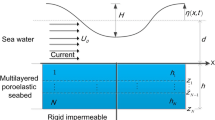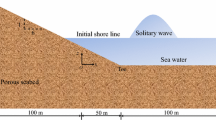Abstract
Wave-induced liquefaction of the seabed is a geohazard frequently encountered in shallow waters. Although widely discussed, most studies paid attention to the seabed response under a single sequence of wave loading. However, the seabed suffers from repeated ‘wave loading-dissipation’ phases in a real ocean environment. In this study, a homogeneous sandy seabed model is established to investigate the mechanism of wave-induced liquefaction by considering the existence of currents. Finite element analyses are conducted by incorporating a kinematic hardening elastoplastic model into the commercial package Abaqus. The constitutive model is validated against centrifugal wave tests. Parametric studies are conducted to demonstrate the effects of relative densities, current, and wave-loading history on the seabed response. The predicted excess pore pressure, effective stress paths, and associated variation of relative density are discussed in detail. The results show that the densification of soils significantly enhances the resistance against liquefaction, which provides new insight into the mechanism of residual liquefaction during wave sequences.
Similar content being viewed by others
References
Asaoka, A., Nakano, M., and Noda, T., 1998. Super loading yield surface concept for the saturated structured soils. Proceedings of the 4th European Conference on Numerical Methods in Geotechnical Engineering-NUMGE98. Udine, 232–242.
Coussy, O., Dormieux, L., and Detournay, E., 1998. From mixture theory to Biot’s approach for porous media. International Journal of Solids and Structures, 35: 4619–4635.
Dassault Systèmes, 2014. Abaqus version 6.14 documentation. Dassault Systèmes Simulia Corp., Providence, RI, USA.
Di, Y., and Sato, T., 2003. Liquefaction analysis of saturated soils taking into account variation in porosity and permeability with large deformation. Computers and Geotechnics, 30: 623–635.
Gao, F. P., and Wu, Y. X., 2006. Non-linear wave-induced transient response of soil around a trenched pipeline. Ocean Engineering, 33: 3–4.
Hashiguchi, K., and Chen, Z. P., 1998. Elasto-plastic constitutive equations of soils with the subloading surface and the rotational hardening. International Journal for Numerical and Analytical Methods in Geomechanics, 22: 197–227.
Hashiguchi, K., and Ueno, M., 1977. Elastoplastic constitutive laws of granular material, constitutive equations of soils. Proceedings of the 9th International Conference on Soil Mechanics and Foundation Engineering. JSSMFE, Tokyo, 73–82.
Hsu, H. C., Chen, Y. Y., Hsu, J. R. C., and Tseng, W. J., 2009. Nonlinear water waves on uniform current in Lagrangian coordinates. Journal of Nonlinear Mathematical Physics, 16: 47–61.
Ishihara, K., 1993. Liquefaction and flow failure during earthquakes. Géotechnique, 43: 351–415.
Jeng, D. S., Seymour, B. R., and Li, J., 2007. A new approximation for pore pressure accumulation in marine sediment due to water waves. International Journal for Numerical and Analytical Methods in Geomechanics, 31: 53–69.
Laitone, E. V., 1962. Limiting conditions for cnoidal and Stokes waves. Journal of Geophysical Research, 67: 1555–1564.
Lanzano, G., Visone, C., Bilotta, E., and Filippo, S. D. M., 2016. Experimental assessment of the stress-strain behaviour of Leighton Buzzard sand for the calibration of a constitutive model. Geotechnical and Geological Engineering, 34: 991–1012.
Li, X. J., Gao, F. P., Yang, B., and Zang, J., 2011. Wave-induced Pore pressure responses and soil liquefaction around pile foundation. International Journal of Offshore and Polar Engineering, 21: 233–239.
Li, Z., Jeng, D. S., Zhu, J. F., and Zhao, H., 2019. Effects of principal stress rotation on the fluid-induced soil response in a porous seabed. Journal of Marine Science and Engineering, 7: 123.
Pastor, M., Zienkiewicz, O. C., and Chan, A. H. C., 1990. Generalized plasticity and the modeling of soil behaviour. International Journal for Numerical and Analytical Methods in Geomechanics, 14: 151–190.
Sassa, S., and Sekiguchi, H., 1999. Wave-induced liquefaction of beds of sand in a centrifuge. Géotechnique, 49: 621–638.
Sassa, S., and Sekiguchi, H., 2001. Analysis of wave-induced liquefaction of sand beds. Géotechnique, 51: 115–126.
Sassa, S., Sekiguchi, H., and Miyamoto, J., 2001. Analysis of progressive liquefaction as a moving-boundary problem. Géotechnique, 51: 847–857.
Sassa, S., Takayama, T., Mizutani, M., and Tsujio, D., 2006. Field observations of the build-up and dissipation of residual pore water pressures in seabed sands under the passage of storm waves. Journal of Coastal Research, 39: 410–414.
Seed, H. B., and Rahman, M. S., 1978. Wave-induced pore pressure in relation to ocean floor stability of cohesionless soils. Marine Geotechnology, 3: 123–150.
Sui, T. T., Zhang, C., Jeng, D. S., Guo, Y. K., Zheng, J. H., Zhang, W., et al., 2019. Wave-induced seabed residual liquefaction around a mono-pile foundation with various embedded depth. Ocean Engineering, 173: 157–173.
Sui, T. T., Zheng, J. H., Zhang, C., Jeng, D. S., Zhang, J. S., Guo, Y. K., et al., 2017. Consolidation of unsaturated seabed around an inserted pile foundation and its effects on the wave-induced momentary liquefaction. Ocean Engineering, 131: 308–321.
Sumer, B. M., Hatipoglu, F., Fredsøe, J., and Sumer, S. K., 2006. The sequence of soil behavior during wave-induced liquefaction. Sedimentology, 53: 611–629.
Sumer, B. M., Kirca, V. S. O., and Fredsøe, J., 2012. Experimental validation of a mathematical model for seabed liquefaction under waves. International Journal of Offshore and Polar Engineering, 22: 133–141.
Tian, Z. C., Guo, X. J., Qiao, L. Z., Yu, L., Xu, G. H., and Liu, T., 2019. Formation mechanism of large pockmarks in the subaqueous Yellow River Delta. Marine Georesources & Geotechnology, 37: 651–659.
Ulker, M. B. C., Rahman, M. S., and Jeng, D. S., 2009. Wave-induced response of seabed: Various formulations and their applicability. Applied Ocean Research, 31: 12–24.
Wang, Z., Yang, Y., and Yu, H., 2017. Effects of principal stress rotation on the wave-seabed interactions. Acta Geotechnica, 12: 97–106.
Wu, J., Kammaerer, A. M., Riemer, M, F., Seed, R. B., and Pestana, J. M., 2004. Laboratory study of liquefaction triggering criteria. Proceedings of 13th World Conference on Earthquake Engineering. Vancouver British Columbia, Canada, Paper No. 2580.
Yamamoto, T., Koning, H., Sellmeijer, H., and Hijum, E. V., 1978. On the response of a poro-elastic bed to water waves. Journal of Fluid Mechanics, 87: 193–206.
Ye, G. L., Leng, J., and Jeng, D. S., 2018. Numerical testing on wave-induced seabed liquefaction with a poro-elastoplastic model. Soil Dynamics and Earthquake Engineering, 105: 150–159.
Ye, J. H., and Jeng, D. S., 2012. Response of porous seabed to nature loadings: Waves and currents. Journal of Engineering Mechanics, 138: 601–613.
Zen, K., and Yamazaki, H., 1990. Mechanism of wave-induced liquefaction and densification in seabed. Soils and Foundations, 30: 90–104.
Zen, K., and Yamazaki, H., 1991. Field observation and analysis of wave-induced liquefaction in seabed. Soils and Foundations, 31: 161–179.
Zhang, F., Ye, B., and Ye, G. L., 2011. Unified description of sand behavior. Frontiers of Architecture and Civil Engineering, 5: 121–150.
Acknowledgements
This paper was supported by the National Natural Science Foundation of China (Nos. U1806230 and 42025702), and the Key Science and Technology Plan of PowerChina Huadong Engineering Corporation (No. KY2018-ZD-01).
Author information
Authors and Affiliations
Corresponding author
Rights and permissions
About this article
Cite this article
Shan, Z., Zhu, Z., Wang, D. et al. Numerical Modeling of the Dynamic Response of an Elastoplastic Seabed Under Wave-Current Interactions. J. Ocean Univ. China 22, 43–52 (2023). https://doi.org/10.1007/s11802-023-5076-9
Received:
Revised:
Accepted:
Published:
Issue Date:
DOI: https://doi.org/10.1007/s11802-023-5076-9




